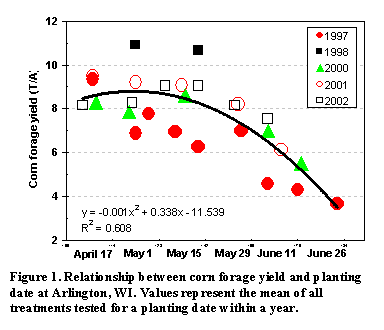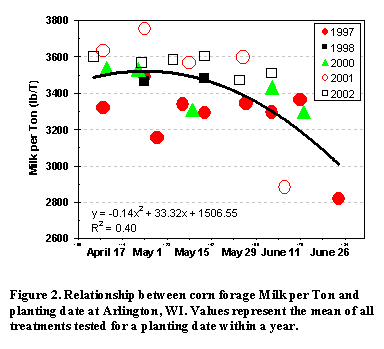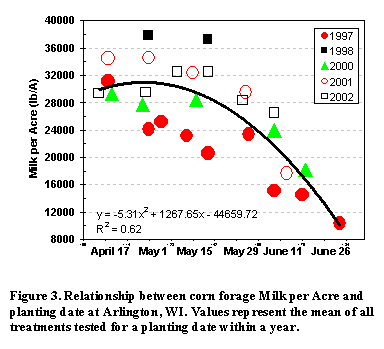
Planting Corn For Silage Following Winter-Killed Alfalfa
April 24, 2003 10(6):46-48
Joe Lauer, Corn Agronomist
Nearly every year, farmers are faced with late planting of corn. Reasons given include:
1) hoping that alfalfa will survive winters where significant kill may have occurred,
2) planting corn following first-cut alfalfa, 3) spring field conditions too wet
to work delaying corn planting, and 4) re-plant situations where frost, disease,
insects and/or soil crusting has reduced stand. In most years, later planting dates
decrease corn grain yield and increase grain moisture.
What happens to corn silage yield and quality with later planting dates? The following
is a summary of planting date trials conducted at Arlington, WI. The objective of
these trials is to measure the impact of planting date on corn forage yield and
quality.
In corn silage a key quality component is the ratio of grain to stover in the forage.
Less grain yield usually lowers silage quality. Corn forage yield decreases with
later planting date (Figure 1). Forage yield of corn planted on June 1 is lower
than earlier planting dates in May and April. By the end of June yield levels
are about 50% of the maximum yields observed around May 1.

Later planting dates do not affect corn stover yield as much as grain yield, so
the grain:stover ratio decreases with later planting date primarily due to lower
grain yield. Lower grain:stover ratio results in less Milk per Ton for June planting
dates than earlier April and May planting dates (Figure 2). Milk per Ton ranged
from 3200 to 3600 lb milk / T for most planting dates in most years, however, the
last planting dates in 1997 and 2001 had significantly lower Milk per Ton values.

Multiplying forage yield by Milk per Ton results in Milk per Acre. The relationship
between Milk per Acre and planting date is shown in Figure 3. By May 20, Milk per
Acre yields are significantly reduced compared to earlier planting dates. Planting
dates the third week in June produce Milk per Acre yields at 50% of the maximum
levels seen in April and early May planting dates.

The adage "Managing corn for optimum silage yield and quality is the same as managing
corn for high grain yield" is appropriate when making late-planting date decisions.
These observations are average responses for full- and shorter-season hybrids. More
information on the role of hybrid maturity for corn planting dates will be presented
in the future.